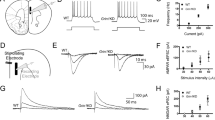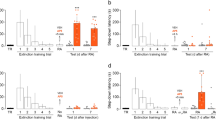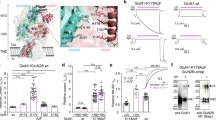Abstract
Glutamate is a major component of the reward circuitry and recent clinical studies suggest that new molecules that would target glutamate neurotransmission are most likely to constitute more effective medications for mood disorders. It is well known that activation of N-methyl-D-aspartate glutamate receptors (NMDARs) initiates dopamine burst firing, a mode associated with reward signaling; but NMDARs also contribute to the maintenance of an inhibitory drive to dopamine neurons. Such opposite modulatory functions imply that different subtypes of NMDARs are expressed on different ventral midbrain (VM) neurons and/or afferent inputs to dopamine neurons. By using the small interfering RNA (siRNA) technique, we studied the effects of VM downregulation of NMDAR subunits GluN1, GluN2A, and GluN2D on reward induced by dorsal raphe electrical stimulation. Reward thresholds were measured before and 24 h after each of three consecutive daily bilateral microinjections of siRNA for the targeted receptor subunit(s) or non-active RNA sequence. After the last measurement, reward thresholds were reassessed following a bilateral microinjection of the preferred GluN2A-NMDA antagonist, (2R,4S)-4-(3-Phosphopropyl)-2-piperidinecarboxylic acid (PPPA). Western-blot analysis showed that siRNAs reduced GluN1- and GluN2A-containing receptors whereas behavioral tests showed that only a reduction in GluN1 produced reward attenuation. Despite NMDAR reduction, reward-enhancing effect of PPPA remained unchanged. We conclude that VM glutamate relays the reward signal initiated by dorsal raphe electrical stimulation by acting on NMDARs devoid of GluN2A/2D subunits and exerts an inhibition on this reward signal by acting on GluN2A-containing NMDARs most likely located on afferent terminals.
Similar content being viewed by others
Log in or create a free account to read this content
Gain free access to this article, as well as selected content from this journal and more on nature.com
or
References
Barr JL, Forster GL, Unterwald EM (2014). Repeated cocaine enhances ventral hippocampal-stimulated dopamine efflux in the nucleus accumbens and alters ventral hippocampal NMDA receptor subunit expression. J Neurochem 130: 583–590.
Bergeron S, Rompré P-P (2013). Blockade of ventral midbrain NMDA receptors enhances brain stimulation reward: a preferential role for GluN2A subunits. Eur Neuropsychopharmacol 23: 1623–1635.
Berman RM, Cappiello A, Anand A, Oren DA, Heninger GR, Charney DS et al (2000). Antidepressant effects of ketamine in depressed patients. Biol Psychiatry 3223 47: 351–354.
Bidoret C, Ayon A, Barbour B, Casado M (2009). Presynaptic NR2A-containing NMDA receptors implement a high-pass filter synaptic plasticity rule. Proc Natl Acad Sci USA 106: 14126–14131.
Bonci A, Malenka RC (1999). Properties and plasticity of excitatory synapses on dopaminergic and GABAergic cells in the ventral tegmental area. J Neurosci 19: 3723–3730.
Carlezon W, Todtenkopf M, McPhie D, Pimentel P, Pliakas A, Stellar JR et al (2001). Repeated exposure to rewarding brain stimulation downregulates GluR1 expression in the ventral tegmental area. Neuropsychopharmacology 25: 234–241.
Carr DB, Sesack SR (2000). Projections from the rat prefrontal cortex to the ventral tegmental area: target specificity in the synaptic associations with mesoaccumbens and mesocortical neurons. J Neurosci 20: 3864–3873.
Chamberlain SEL, Yang J, Jones RSG (2008). The role of NMDA receptor subtypes in short-term plasticity in the rat entorhinal cortex. Neural Plast 2008: 872456.
Charlety PJ, Grenhoff J, Chergui K, De la Chapelle B, Buda M, Svensson TH et al (1991). Burst firing of mesencephalic dopamine neurons is inhibited by somatodendritic application of kynurenate. Acta Physiol Scand 142: 105–112.
Chergui K, Charléty PJ, Akaoka H, Saunier CF, Brunet JL, Buda M et al (1993). Tonic activation of NMDA receptors causes spontaneous burst discharge of rat midbrain dopamine neurons in vivo. Eur J Neurosci 5: 137–144.
Cornish JL, Nakamura M, Kalivas PW (2001). Dopamine-independent locomotion following blockade of N-methyl-D-aspartate receptors in the ventral tegmental area. J Pharmacol Exp Ther 298: 226–233.
David V, Durkin TP, Cazala P (1998). Rewarding effects elicited by the microinjection of either AMPA or NMDA glutamatergic antagonists into the ventral tegmental area revealed by an intracranial self-administration paradigm in mice. Eur J Neurosci 10: 1394–1402.
Dobi A, Margolis EB, Wang H-L, Harvey BK, Morales M (2010). Glutamatergic and nonglutamatergic neurons of the ventral tegmental area establish local synaptic contacts with dopaminergic and nondopaminergic neurons. J Neurosci 30: 218–229.
Ducrot C, Fortier E, Bouchard C, Rompré P-P (2013). Opposite modulation of brain stimulation reward by NMDA and AMPA receptors in the ventral tegmental area. Front Syst Neurosci 7: 57.
Dunah AW, Yasuda RP, Wang YH, Luo J, Dávila-García M, Gbadegesin M et al (1996). Regional and ontogenic expression of the NMDA receptor subunit NR2D protein in rat brain using a subunit-specific antibody. J Neurochem 67: 2335–2345.
Floresco SB, West AR, Ash B, Moore H, Grace AA (2003). Afferent modulation of dopamine neuron firing differentially regulates tonic and phasic dopamine transmission. Nat Neurosci 6: 968–973.
Fond G, Loundou A, Rabu C, Macgregor A, Lançon C, Brittner M et al (2014). Ketamine administration in depressive disorders: a systematic review and meta-analysis. Psychopharmacology (Berl) 231: 3663–3676.
French ED, Mura A, Wang T (1993). MK-801, phencyclidine (PCP), and PCP-like drugs increase burst firing in rat A10 dopamine neurons: comparison to competitive NMDA antagonists. Synapse 13: 108–116.
Geisler S, Derst C, Veh RW, Zahm DS (2007). Glutamatergic afferents of the ventral tegmental area in the rat. J Neurosci 27: 5730–5743.
Gipson C, Reissner K (2013). Reinstatement of nicotine seeking is mediated by glutamatergic plasticity. Proc Natl Acad Sci USA 110: 10–15.
Grace AA, Bunney BS (1984). The control of firing pattern in nigral dopamine neurons: burst firing. J Neurosci 4: 2877–2890.
Greenberg P, Corey-Lisle PK, Birnbaum H, Marynchenko M, Claxton A (2004). Economic implications of treatment-resistant depression among employees. Pharmacoeconomics 22: 363–373.
Hernandez G, Breton Y-A, Conover K, Shizgal P (2010). At what stage of neural processing does cocaine act to boost pursuit of rewards? PLoS One 5: e15081.
Hernández G, Shizgal P (2009). Dynamic changes in dopamine tone during self-stimulation of the ventral tegmental area in rats. Behav Brain Res 198: 91–97.
Hioki H, Nakamura H, Ma Y-F, Konno M, Hayakawa T, Nakamura KC et al (2010). Vesicular glutamate transporter 3-expressing nonserotonergic projection neurons constitute a subregion in the rat midbrain raphe nuclei. J Comp Neurol 518: 668–686.
Humeau Y, Shaban H, Bissière S, Lüthi A (2003). Presynaptic induction of heterosynaptic associative plasticity in the mammalian brain. Nature 426: 841–845.
Kalivas PW, Churchill L, Klitenick MA (1993). GABA and enkephalin projection from the nucleus accumbens and ventral pallidum to the ventral tegmental area. Neuroscience 57: 1047–1060.
Karreman M, Westerink BH, Moghaddam B (1996). Excitatory amino acid receptors in the ventral tegmental area regulate dopamine release in the ventral striatum. J Neurochem 67: 601–607.
Kindlundh-Högberg AMS, Blomqvist A, Malki R, Schiöth HB (2008). Extensive neuroadaptive changes in cortical gene-transcript expressions of the glutamate system in response to repeated intermittent MDMA administration in adolescent rats. BMC Neurosci 9: 39.
Kretschmer BD (1999). Modulation of the mesolimbic dopamine system by glutamate: role of NMDA receptors. J Neurochem 73: 839–848.
Kupfer DJ, Ellen F, Perel JM (1989). The advantage of early treatment intervention in recurrent depression. Arch Gen Psychiatry 46: 771–775.
Li YH, Han TZ, Meng K (2008). Tonic facilitation of glutamate release by glycine binding sites on presynaptic NR2B-containing NMDA autoreceptors in the rat visual cortex. Neurosci Lett 432: 212–216.
Liu Z, Zhou J, Li Y, Hu F, Lu Y, Ma M et al (2014). Dorsal raphe neurons signal reward through 5-HT and glutamate. Neuron 81: 1360–1374.
Maeng S, Zarate CA, Du J, Schloesser RJ, McCammon J, Chen G et al (2008). Cellular mechanisms underlying the antidepressant effects of ketamine: role of alpha-amino-3-hydroxy-5-methylisoxazole-4-propionic acid receptors. Biol Psychiatry 63: 349–352.
Mathew SS, Hablitz JJ (2011). Presynaptic NMDA receptors mediate IPSC potentiation at GABaergic synapses in developing rat neocortex. PLoS One 6: e17311.
Mcdevitt RA, Tiran-cappello A, Harvey BK, Bonci A, Shen H, Balderas I et al (2014). Serotonergic versus nonserotonergic dorsal raphe projection neurons: differential participation in reward article serotonergic versus nonserotonergic dorsal raphe projection neurons: differential participation in reward circuitry. Cell Rep 8: 1857–1869.
McGirr A, Berlim MT, Bond DJ, Fleck MP, Yatham LN, Lam RW (2014). A systematic review and meta-analysis of randomized, double-blind, placebo-controlled trials of ketamine in the rapid treatment of major depressive episodes. Psychol Med 10: 1–12.
Miliaressis E, Rompre PP, Laviolette P, Philippe L, Coulombe D (1986). The curve-shift paradigm in self-stimulation. Physiol Behav 37: 85–91.
Moisan J, Rompre PP (1998). Electrophysiological evidence that a subset of midbrain dopamine neurons integrate the reward signal induced by electrical stimulation of the posterior mesencephalon. Brain Res 786: 143–152.
Nakajima S, Patterson RL (1997). The involvement of dopamine D2 receptors, but not D3 or D4 receptors, in the rewarding effect of brain stimulation in the rat. Brain Res 760: 74–79.
Nestler EJ, Carlezon WA (2006). The mesolimbic dopamine reward circuit in depression. Biol Psychiatry 59: 1151–1159.
Nugent FS, Kauer JA (2008). LTP of GABAergic synapses in the ventral tegmental area and beyond. J Physiol 586: 1487–1493.
Omelchenko N, Sesack SR (2009). Ultrastructural analysis of local collaterals of rat ventral tegmental area neurons: GABA phenotype and synapses onto dopamine and GABA cells. Synapse 63: 895–906.
Overton PG, Clark D (1997). Burst firing in midbrain dopaminergic neurons. Brain Res Brain Res Rev 25: 312–334.
Paquet M, Smith Y (2000). Immunoreactivity in GABAergic terminals in rat brain. J Comp Neurol 347: 330–347.
Paxinos G, Watson C (2007) The Rat Brain in Stereotaxic Coordinates Sixth Edition Elsevier Acad Press, 170: 547–612.
Pinheiro PS, Mulle C (2008). Presynaptic glutamate receptors: physiological functions and mechanisms of action. Nat Rev Neurosci 9: 423–436.
Qi J, Zhang S, Wang H-L, Wang H, de Jesus Aceves Buendia J, Hoffman AF et al (2014). A glutamatergic reward input from the dorsal raphe to ventral tegmental area dopamine neurons. Nat Commun 5: 5390.
Ren M, Yoshimura Y, Takada N, Horibe S, Komatsu Y (2007). Specialized inhibitory synaptic actions between nearby neocortical pyramidal neurons. Science 316: 758–761.
Rompré PP, Bauco P (1990). GBR 12909 reverses the SCH 23390 inhibition of rewarding effects of brain stimulation. Eur J Pharmacol 182: 181–184.
Salahpour A, Medvedev IO, Beaulieu J-M, Gainetdinov RR, Caron MG et al (2007). Local knockdown of genes in the brain using small interfering RNA: a phenotypic comparison with knockout animals. Biol Psychiatry 61: 65–69.
Schilström B, Yaka R, Argilli E, Suvarna N, Schumann J, Chen BT et al (2006). Cocaine enhances NMDA receptor-mediated currents in ventral tegmental area cells via dopamine D5 receptor-dependent redistribution of NMDA receptors. J Neurosci 26: 8549–8558.
Schultz W (2010). Dopamine signals for reward value and risk: basic and recent data. Behav Brain Funct 6: 24.
Smith KS, Tindell AJ, Aldridge JW, Berridge KC (2009). Ventral pallidum roles in reward and motivation. Behav Brain Res 196: 155–167.
Strekalova T, Couch Y, Kholod N, Boyks M, Malin D, Leprince P et al (2011). Update in the methodology of the chronic stress paradigm: internal control matters. Behav Brain Funct 7: 9.
Watabe-Uchida M, Zhu L, Ogawa SK, Vamanrao A, Uchida N (2012). Whole-brain mapping of direct inputs to midbrain dopamine neurons. Neuron 74: 858–873.
You ZB, Chen YQ, Wise RA (2001). Dopamine and glutamate release in the nucleus accumbens and ventral tegmental area of rat following lateral hypothalamic self-stimulation. Neuroscience 107: 629–639.
Yuan T, Mameli M, O’Connor EC, Dey PN, Verpelli C, Sala C et al (2013). Expression of cocaine-evoked synaptic plasticity by GluN3A-containing NMDA receptors. Neuron 80: 1025–1038.
Zweifel LS, Parker JG, Lobb CJ, Rainwater A, Wall VZ, Fadok JP et al (2009). Disruption of NMDAR-dependent burst firing by dopamine neurons provides selective assessment of phasic dopamine-dependent behavior. Proc Natl Acad Sci USA 106: 7281–7288.
Acknowledgements
The present research was supported by NSERC grant #119057 to Pierre-Paul Rompré, NSERC fellowship to Giovanni Hernandez. We thank Claude Bouchard for is excellence assistance and Sandra M Boye for her helpful suggestions.
Author information
Authors and Affiliations
Corresponding author
Additional information
Supplementary Information accompanies the paper on the Neuropsychopharmacology website
Rights and permissions
About this article
Cite this article
Hernandez, G., Khodami-Pour, A., Lévesque, D. et al. Reduction in Ventral Midbrain NMDA Receptors Reveals Two Opposite Modulatory Roles for Glutamate on Reward. Neuropsychopharmacol 40, 1682–1691 (2015). https://doi.org/10.1038/npp.2015.14
Received:
Revised:
Accepted:
Published:
Issue date:
DOI: https://doi.org/10.1038/npp.2015.14



